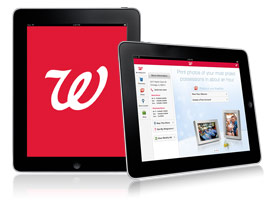The Future of Couponing | How Social-Local-Mobile has Changed the Game
“The object is to exploit the convergence of people, information, products, services and places with today’s smartphones and tablets, which drive online orders in addition to purchases from brick-and-mortar stores.”
– Paul Breummer, Search Engine Land
 In April 2011, the Association of Coupon Professionals held an Industry Conference in Atlanta to address the present and future state of couponing. The industry had seen unprecedented growth in the past decade due to a combination of factors, one of which was the United States’ economic recession. “The rise of couponing in late 2008 coincided with the recession of the late 2000s;” this factor combined with an increased consumer interest in mobile technology and devices led to an unprecedented decline in print media.
In April 2011, the Association of Coupon Professionals held an Industry Conference in Atlanta to address the present and future state of couponing. The industry had seen unprecedented growth in the past decade due to a combination of factors, one of which was the United States’ economic recession. “The rise of couponing in late 2008 coincided with the recession of the late 2000s;” this factor combined with an increased consumer interest in mobile technology and devices led to an unprecedented decline in print media.
Due to the combination of these factors, marketers began to more heavily fund digital platforms. The coupon industry specifically saw record growth within the digital realm, and by 2010 “49 million people [had] used an online coupon.”
The benefits “digital interactions” have and continue to offer coupon companies are vast. For starters, online couponing allows for great promotion of brands and wider distribution; not to mention it also allows companies to better reach & track consumer preferences and patterns. Precise analytics allow companies to “measure online distribution of coupons by tracking the printing of web pages and page views;” a significant advantage with digital.
What these and other analytics showed was that the digital coupon consumer base was “young, married, and had disposable income.” Groupon specifically has targeted this demographic, lending digital couponing a social reputation. “Daily deal” couponing continues to be a popular tool among consumers and marketers, and many major companies have implementing their own version of the trend.
Statistics from 2008 show that digital couponing has rapidly grown but has yet to outpace paper coupons. At that time, digital accounted for “less than 1/10 of all coupons distributed.” But subsequent statistics have also shown that “online coupon access [has] increased 92 percent and redemption of Internet deals [has] leapt up 360 percent;” with more growth predicted in 2012. All-in-all one study found that “1 in 5 people who receive an Internet coupon redeemed it;” so clearly digital couponing is more than just “another distribution channel,” as some analysts have previously stated.
Problems Daily Deal Couponing Presented for Business Owners
While intriguing for consumers, daily deal couponing platforms like Groupon have not always been beneficial for business owners who often see a spike in business with little retention of those customers.
“A study conducted by Rice University’s Jesse H. Jones Graduate School of Business found that 66 percent of the 150 businesses surveyed reported that Groupon promotions [were] profitable. However, more than 40 percent of the organizations said that they wouldn’t run a Groupon offer again.”
But what Groupon (and Living Social’s) platforms have revealed is the social nature of contemporary couponing. For example, Cornell University reported that many Groupon users see themselves as “marketing mavens”… “on the front edge of market trends and price information.” Additionally, users claim they “would not have tried a restaurant [or store] without a coupon offer.” What theses statements reveal is the social branding that has been bestowed upon contemporary couponing thanks in great deal to the popularity of “daily deals.”
Social Leads to Social Sharing
 The social, daily deal strategies that Groupon (and Living Social) made popular have certainly spawned many copycat initiatives within the social, digital couponing realm. One such example is SocialTwist, a platform that “allows users to share in order to receive a better bargain.” The basic concept being that consumers can turn a $1 coupon into a $4 coupon simply by sharing it with 4 other people. According to one study this method has proven popular as “SocialTwist’s social coupons receive a 50-80 percent redemption rate.” It has been predicted that this method will continue to increase in popularity in 2012. Evidence of this was seen in late November 2011, when Foursquare announced they will be incorporating a new “social sharing” button on their site.
The social, daily deal strategies that Groupon (and Living Social) made popular have certainly spawned many copycat initiatives within the social, digital couponing realm. One such example is SocialTwist, a platform that “allows users to share in order to receive a better bargain.” The basic concept being that consumers can turn a $1 coupon into a $4 coupon simply by sharing it with 4 other people. According to one study this method has proven popular as “SocialTwist’s social coupons receive a 50-80 percent redemption rate.” It has been predicted that this method will continue to increase in popularity in 2012. Evidence of this was seen in late November 2011, when Foursquare announced they will be incorporating a new “social sharing” button on their site.
Getting Mobile-Ready
Given these newer strategies companies are mobilizing their virtual and physical platforms to better reach and retain these social, mobile customers. Most companies are aware now more than ever that their mobile presence has to be dynamic and user friendly. With roughly 91% of the population using mobile devices and 26.3% accessing the Internet, it is important to have a “mobile ready” site for easy mobile reading and utilization.
In addition to this, “Google has reported [that] 95% of smartphone users have searched for local information,” while using their mobile devices- proving that location based, deal searching is another important aspect of mobile coupon use.
“The study also found 38 percent of users would use a mobile device to find a store location, 34 percent to compare prices, 28 percent to research deals and coupons, and 27 percent to find a product review.”
These statistics provide even greater incentive for businesses to have mobile ready sites so that they can engage local users looking for discounted goods and services.
Resolving Mobile Couponing’s Redemption Pitfalls
 Mobile couponing, an obvious extension and result of digital distribution, has been popular despite its “mechanical” issues. With the rise of digital coupons, so came a rise in consumers using their mobile devices to reference coupons visually on their smartphones. Unprepared for this development, the redemption process, i.e. the scanning of digital coupons on mobile devices, has proven difficult until recently.
Mobile couponing, an obvious extension and result of digital distribution, has been popular despite its “mechanical” issues. With the rise of digital coupons, so came a rise in consumers using their mobile devices to reference coupons visually on their smartphones. Unprepared for this development, the redemption process, i.e. the scanning of digital coupons on mobile devices, has proven difficult until recently.
“Mobile coupon redemption has always struggled with ensuring a seamless experience at the point of sale,” contemporary research states. So, business giants like Walgreen’s Drug Store have “retrained salespeople to handle the process [and] equipped stores with hardware that can recognize 2D codes on LCD displays.” This nationwide initiative was just launched and will undergo testing during the 2011 Holiday Season.
“A re-release of the Walgreens app for iOS, BlackBerry and Android included a new coupons section that will issue up to three new deals each week exclusively for customers using the mobile apps. Rich Lesperance, head of digital marketing and merging media, Walgreens, says the program is the largest deployment of in-store mobile coupon scanning of which he is aware.”
Looking Ahead to the “Social-Local-Mobile” Strategy
 According to an article published on December 1st, 2011 in Search Engine Land, the “social-local-mobile” trend is the next cutting edge move for digital businesses and a necessary consideration for coupon brands.# Social-local-mobile (SLM) gets specific when it comes to targeting your ideal market and allows your ideal consumer to find you. A win for both parties, as well as the logical next step for consumer activity based on current digital engagement.
According to an article published on December 1st, 2011 in Search Engine Land, the “social-local-mobile” trend is the next cutting edge move for digital businesses and a necessary consideration for coupon brands.# Social-local-mobile (SLM) gets specific when it comes to targeting your ideal market and allows your ideal consumer to find you. A win for both parties, as well as the logical next step for consumer activity based on current digital engagement.
An impressive “two-thirds of holiday shoppers would make a purchase from mobile phones if prompted by coupons, discounts, text alerts, gift cards or loyalty points. That’s an increase from the 32 percent that responded positively last year,” claims
a new survey by Sybase 365 and the Mobile Marketing Association. In short, businesses looking to stay on top of the digital couponing trends need to focus on the being strong on three fronts: social, local and mobile. As the combination of the three provide the ultimate benefit.
Submited by GroceryCouponNetwork.com. Credit for the writing and research of this article and content above goes to them as well.








